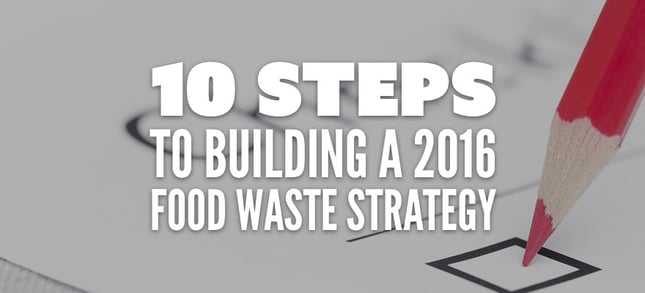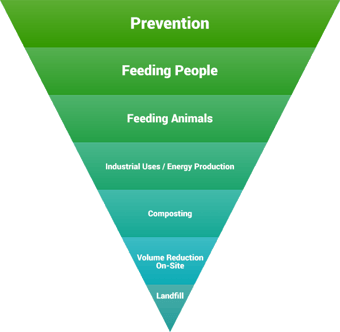10 Steps to a Building a 2016 Food Waste Strategy

What's your operation's strategy to minimize wasted food? If you're like many foodservice operators, you might be feeling a bit overwhelmed by all of the potential solutions to this critical issue, and wondering where you should start.
Earlier this month we held a webinar to provide guidance on just that: Building Your 2016 Food Waste Strategy, a Checklist for Success. Crafting a strategy can feel like a daunting task, but we simplified it to just 10 steps to help get you started in the right direction. If you missed it, you can still watch the full recording and download the companion "Checklist" template. For a cliff notes version, read on.
Step 1: Define your values food waste values.
First, everyone needs to be on the same page about why you're focusing on minimizing wasted food. Why does your operation care about reducing food waste? Is it to further your organization's sustainability goals? Reduce food costs? Build a stronger PR / social awareness platform?
Step 2: Set SMART goals for wasted food in 2016.
Goals are critical for measuring success. And at LeanPath, we’re strong believers in SMART goals: specific, measurable, attainable, realistic, and time-bound. By the end of 2016, where do you want to be?
Step 3: Document your wasted food starting point / baseline.
It's very important to have data and know where you are today, in order to understand if you've achieved your goal. If you’re not measuring your food waste, this will likely emerge as one of your strategies for the year. Document your current waste generation levels if you're already tracking, or conduct a food waste audit to set your baseline. (Check out our How to Conduct a Food Waste Audit e-guide for more info.)
Step 4: Itemize your current food waste reduction initiatives, and then categorize them based on the hierarchy.
 What are you already doing to address food waste? For some operations this list is expansive, for others it might be sparse. Whatever the case, write down everything you're doing, from donating food to composting to talking to employees about the issue. Next, compare each initiative to the food waste hierarchy (pictured here; adapted from the U.S. EPA Food Recovery Hierarchy) and indicate which bucket it falls in.
What are you already doing to address food waste? For some operations this list is expansive, for others it might be sparse. Whatever the case, write down everything you're doing, from donating food to composting to talking to employees about the issue. Next, compare each initiative to the food waste hierarchy (pictured here; adapted from the U.S. EPA Food Recovery Hierarchy) and indicate which bucket it falls in.
Step 5: Score your portfolio of food waste activities.
If you haven't downloaded the LeanPath Checklist, you'll need to do that for this step. In the table listing food waste initiatives, you'll check the box on the ones you're already doing, such as daily measurement of food waste, trayless dining, donating excess edible food, etc. We’ve given each item a score, based on its financial, environmental and social impact—guided by the food waste hierarchy. Add up your score, and indicate where you currently fall on the food waste spectrum, from "Food Waste Apprentice," to "Food Waste Fighter," to "Food Waste Master."
Step 6: Make a food waste plan.
Now that you've assessed what you're currently doing, and have your overall score to guide you, you can start prioritizing what new initiatives you’ll focus on in 2016. For a "Food Waste Apprentice" starting to measure food waste is usually a good place to start. Data provides consistent focus, allowing you to set goals, track improvement and engage your team. (Check out LeanPath systems for more information on automated solutions for daily measurement.) For "Food Waste Fighters" you might already be measuring daily, and ready to move onto the next tier of the hierarchy, feeding people. For "Food Waste Masters" who are likely already preventing and donating excess food, it may be time to look at food waste diversion, starting with industrial uses/energy production. Each situation will be unique.
Step 7: Attach your new strategies to your goals and adjust priorities if necessary.
Remember the goals you set in Step 2? The initiatives you prioritize in Step 6 should align with those goals. If they don’t, you may need to re-think and adjust.
Step 8: Define your immediate action steps.
What will you do to put your plan in motion? When will you do it? Who needs to be involved? This is a very important step to ensuring all of the ideas you come up with get implemented.
Step 9: Garner support for your plan.
You'll need to create a team to champion your wasted food strategy. Once this team is in place and your strategy is set, everyone in your operation should understand your plan – why it's important, what you’re planning to do, and how you’ll measure success. From the hostess to the dishwasher, everyone in your operation who touches food needs to be part of the solution and buy in.
Step 10: Make your commitment to reduce food waste public.
If we make our strategy public, we’ll be much more likely to stick with it. Consider making posters about your strategy or goals that you'll post around your operation. Depending on your area of focus, it might be something you share externally with your local community, and look to gather press attention for further awareness.
With a concrete plan in action 2016 can be your year to fight food waste!
For more information on LeanPath solutions or to discuss your 2016 strategy with a LeanPath food waste expert, email us at info@leanpath.com.